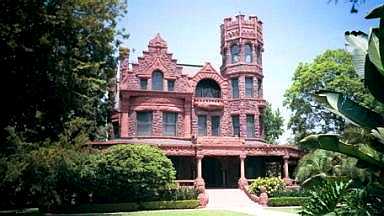

I received E-Mail that said:
There is a romanesque mansion on Figueoa street near Adams in Los Angeles, I have a small picture......it is a nunnery now but has been used in many motion pictures most notably HOUSE II, and is called the Stimson House.
Later, I received E-Mail that said:
I have some information for you regarding the Stimson house, located at 2421 S. Figueroa Street in Los Angeles, CA. It's a lot to read, but the Stimson house is just so wonderful it's story should be told...
Completed in 1893, this was the home of Thomas Douglas Stimson. Born in New York state in 1827, Stimson began work in the lumber business at age 14. He found great success early on in his career. He later relocated to Michigan, married, and raised a family in the town of Big Rapids. In 1877, he constructed a large home there in the French mansard style, which was popular at the time.
Later joined by his sons, the family business relocated to Chicago, sometime in the 1880s. At that time the family purchased a spacious townhouse on South Calumet Avenue, then in the heart of an upscale community filled with the imposing homes of Chicago's wealthy business leaders...this neighborhood centered on Michigan Avenue and Prairie Avenue. The Stimson house, like its neighbors, was of masonry construction in a style later termed the Richardsonian Romanesque, after the well known Boston architect H. H. Richardson. Characteristics of this style include rough finished masonry walls, frequently of brownstone or limestone, rows of windows (either arched or rectangular in shape), and an overall fortress-like quality to the design. This style of homebuilding, usually reserved for the wealthy due to its expensive construction, was very popular in the Chicago area and abroad. And it undoubtedly had a strong influence on T. D. Stimson.
Upon retirement in the early 1890s, Stimson decided to relocate to the more healthful climate of Southern California. He purchased property south of downtown Los Angeles, and began planning his new home. He selected an unknown local architect named H. Carroll Brown, to design the house. Brown himself had relocated from Illinois about a decade earlier, and was clearly familiar with the kind of home Stimson had grown accustomed to while living in Chicago.
The house Brown created for the Stimson family stood 3 1/2 stories tall, with a four story corner tower. Its design included elements from the Romanesque style, as well as Classically-influenced columns, Gothic arches, and an overall shape reminiscent of the Queen Anne style. It cost $130,000 to build, making it the most expensive house built in Los Angeles at the time. The massive masonry house stood in great contrast to the more delicate wood frame houses which dominated the neighborhood at that time.
Appropriate for the home of a lumberman, the interior featured a wide array of woodwork, including handcarved wall paneling and beamed ceilings crafted from a variety of wood. The interior decorating was left to Carsley and East of Chicago, who, at Stimson's request, replicated much of the woodwork detail found in his former home in Chicago. Much of the building materials for the house, as well as the furniture, was sent by rail, as the architect apparently had difficulty obtaining the appropriate materials locally.
Inside, visitors passed through the stone veranda into the spacious wood paneled entrance. To the left was the front parlor, and a separate reception room was located nearby. Beyond was the rear parlor, whose entry was framed with marble columns; this room featured a marble fireplace and built-in cabinetry. And to the rear was the dining room, which included a built-in corner china cabinet. A private study for Mr. Stimson was included in one corner of the first floor, and at the rear of the house was the kitchen and service areas.
The main staircase, with an elaborate wood newel post, was lighted with numerous stained glass windows as it rose to the top of the house. The second floor contained bedrooms for the family and guests, and the third floor housed additional bedrooms for the children and servants.
Stimson later retained architect Brown for a large business building constructed at Third and Spring Streets in downtown Los Angeles. Named the Stimson Block, this building shares many features with the Stimson's home, including the heavy masonry construction, arched windows, and a rounded corner tower.
T. D. Stimson died in 1898. His widow continued to live in the home until her death in 1904. It was at that time that the house was sold to a prosperous brewer named Edward Maier. By the 1940s it was occupied by a fraternity for the University of Southern California. Later purchased by a neighbor (supposedly to put an end to the noisy fraternity parties), the Stimson house and several neighboring properties were donated to Mount St. Mary's College. The Stimson house was then used as a residence hall for students.
Numerous family members later relocated to the Seattle, Washington region, to be closer to their lumber interests. There they continued the tradition begun by T. D. Stimson...constructing wonderful buildings for home and for work. Later generations of Stimsons usually chose the English Tudor style for their homes. And as with the earlier Stimson house, these houses feature a spaciousness and a quality of craftsmanship that began with the Figueroa Street "castle."
If you are interested in more information, I recommend the book "The Stimson Legacy: Architecture in the Urban West," by Lawrence Kreisman. It was from this book that most of this information was gleaned.
On 10-25-07, I received e-mail that said:
The castle is currently being depicted as a funeral home on the ABC series "Pushing Daisies."
On 6-4-11, I received these links:
http://www.usc.edu/libraries/archives/la/historic/stimson_house.html
http://www.pasadenashowcase.org/images/uploads/File/PR%20STIMSON%20HOUSE%20HISTORY.pdf
On 7-16-11, I received e-mail with this link:
http://en.wikipedia.org/wiki/Stimson_House
Back to "Castles of the United States"
Picture courtesy of Paul Ford, info courtesy of Kevin Peterson.